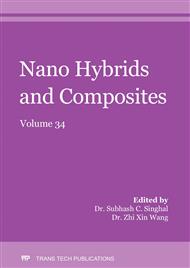[1]
Agopyan, H. J. Savastano, V. M. John and M. A. Cincotto, Developments on vegetable fibre-cement based materials in Sao Paulo, Brazil: an overview,, Cement and Concrete Composites, vol. 27, no. 5, pp.527-536, (2005).
DOI: 10.1016/j.cemconcomp.2004.09.004
Google Scholar
[2]
J. Claramunt, F.-C. J. Lucía, H. Ventura and M. Ardanuy, Natural fiber nonwoven reinforced cement composites as sustainable,, Construction and Building Materials, pp.230-239, (2016).
DOI: 10.1016/j.conbuildmat.2016.04.044
Google Scholar
[3]
J. Wei and C. Meyer, Degradation mechanisms of natural fiber in the matrix of cement composites,, Cement and Concrete Research, vol. 73, pp.1-16, (2015).
DOI: 10.1016/j.cemconres.2015.02.019
Google Scholar
[4]
J. Wei and C. Meyer, Improving degradation resistance of sisal fiber in concrete through fiber surface treatment,, Applied Surface Science, vol. 289, pp.511-523, (2014).
DOI: 10.1016/j.apsusc.2013.11.024
Google Scholar
[5]
M. S. Sreekala, M. G. Kumaran and S. Thomas, Oil palm fibers: morphology, chemical composition, surface modification, and mechanical properties,, Journal of Applied Polymer Science, vol. 66, no. 5, pp.821-835, (1997).
DOI: 10.1002/(sici)1097-4628(19971031)66:5<821::aid-app2>3.0.co;2-x
Google Scholar
[6]
Y. Zhou, M. Fan and C. Lihui, Interface and bonding mechanisms of plant fibre composites: an overview,, Composites Part B, vol. 101, pp.31-45, (2016).
DOI: 10.1016/j.compositesb.2016.06.055
Google Scholar
[7]
E. B. C. Santos, C. G. Moreno, J. J. P. Barros, D. A. de Moura, F. F. de-Carvelho, A. Ries, R. M. R. Wellen and L. B. Da Silva, Effect of alkaline and hot water treatments on the structure and morphology of piassava fibers,, Materials Research, vol. 21, no. 2, (2018).
DOI: 10.1590/1980-5373-mr-2017-0365
Google Scholar
[8]
E. O. Momoh and B. I. O. Dahunsi, Suitability of oil-palm-broom-fibres as reinforcement for laterite-based roof tiles,, International Journal of Software & Hardware Research in Engineering, vol. 5, no. 4, pp.27-35, (2017).
Google Scholar
[9]
E. O. Momoh and A. I. Osofero, Behaviour of oil palm broom fibres (OPBF) reinforced concrete,, Construction and Building Materials, vol. 221, pp.745-761, (2019).
DOI: 10.1016/j.conbuildmat.2019.06.118
Google Scholar
[10]
E. O. Momoh, A. I. Osofero, A. Martinez-felipe and F. Hamza, Physico-mechanical behaviour of Oil Palm Broom Fibres (OPBF) as eco-friendly building material,, Journal of Building Engineering, vol. 30, p.101208, (2020).
DOI: 10.1016/j.jobe.2020.101208
Google Scholar
[11]
E. O. Momoh, A. I. Osofero and O. Menshykov, Bond behaviour of oil palm broom fibres in concrete for eco-friendly construction,, Proceedings of the Institution of Civil Engineers - Construction Materials, vol. 174, no. 1, pp.47-64, (2021).
DOI: 10.1680/jcoma.19.00097
Google Scholar
[12]
E. O. Momoh and A. I. Osofero, Recent Developments in the Application of Oil Palm Fibres in Cement Composites,, Frontiers of Structural and Civil Engineering, vol. 14, no. 1, pp.94-108, (2020).
DOI: 10.1007/s11709-019-0576-9
Google Scholar
[13]
E. O. Momoh, A. I. Osofero and O. Menshykov, Physicomechanical properties of treated oil palm broom-fibres for cementitious composites,, Journal of Materials in Civil Engineering, vol. 32, no. 10, p.04020300, (2020).
DOI: 10.1061/(asce)mt.1943-5533.0003412
Google Scholar
[14]
D. L. Naik, A. Sharma, R. R. Chada, R. Kiran and T. Sirotiak, Modified pullout test for indirect characterization of natural fiber and cementitious matrix interface properties,, Construction and Building Materials, vol. 2018, pp.381-393, (2019).
DOI: 10.1016/j.conbuildmat.2019.03.021
Google Scholar
[15]
D. V. Soulioti, N.-M. Barkoula, F. Koutsianopoulos, N. Charalambakis and T. E. Matikas, The effect of fibre chemical treatment on the steel fibre/cementitious matrix interface,, Construction and Building Materials, vol. 40, pp.77-83, (2013).
DOI: 10.1016/j.conbuildmat.2012.09.111
Google Scholar
[16]
N. Nindyawati and B. S. Umniati, Bond strength of bamboo reinforcement in lightweight concrete,, Journal of Civil Engineering and Architecture, vol. 10, pp.417-420, (2016).
DOI: 10.17265/1934-7359/2016.04.003
Google Scholar
[17]
H. Sakaray, N. V. V. K. Togati and I. V. R. Reddy, Investigation on properties of bamboo as reinforcing material in concrete,, International Journal of Engineering Research and Applications (IJERA), vol. 2, no. 1, pp.77-83, (2012).
Google Scholar
[18]
K. Ghavami, Ultimate Load Behaviour of Bamboo-Reinforced Lightweight Concrete Beams,, Cement and Concrete Composites, vol. 17, pp.281-288, (1995).
DOI: 10.1016/0958-9465(95)00018-8
Google Scholar
[19]
S. Y. Kute and M. R. Wakchaure, Performance evaluation for enhancement of some of the engineering properties of bamboo as reinforcement in concrete,, Journal of The Institution of Engineers (India): Series A, vol. 94, no. 4, pp.235-242, (2013).
DOI: 10.1007/s40030-014-0063-1
Google Scholar


